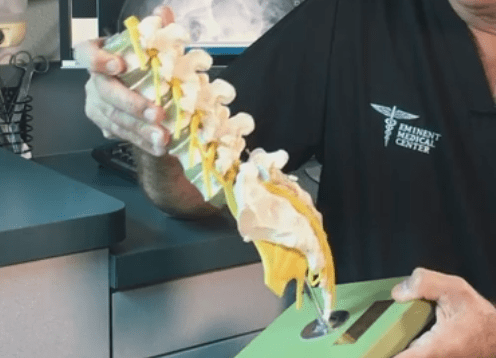If you’ve been diagnosed with spinal stenosis, you’re likely wondering exactly what causes this spine condition and the treatment options available to you. At Plano Orthopedic Sports Medicine and Spine Center (POSMC), Dr. Stephen Courtney and our team believe in educating our patients, so you can play an active role in your treatment. Following is some information that will help you understand the cause of spinal stenosis and your available treatment options.
What is spinal stenosis?
Spinal stenosis is the narrowing of the spinal canal that houses the spinal cord and nerve roots of the spine. There are many types of spinal stenosis, including central canal stenosis, lumbar spinal stenosis and cervical spinal stenosis.
Spinal stenosis generally occurs in two sections of the spine: cervical and lumbar. The cervical spine is located in the neck, and the lumbar spine is located in the lower back. The reason why these two sections are diagnosed with spinal stenosis more than the thoracic spine (middle of the back) is that the cervical and lumbar spine serves to bend, move, and provide flexibility. The thoracic spine’s main function is to provide support and stabilization. When the spinal canal narrows, the nerves in the spinal cord are more likely to be compressed if there is continual bending and moving of the vertebrae. For this reason, spinal stenosis is more evident and symptomatic in the cervical and lumbar sections of the spine.
What causes spinal stenosis?
Determining the cause of spinal stenosis can be complicated because, while spinal stenosis is the narrowing of the spinal canal, there is usually an underlying spine condition that is causing the spinal canal to narrow. For example, a bulging or herniated disc would cause the spinal canal to narrow in a particular place because the bulging disc has moved out of its normal zone in the spine. In this case, the patient would have spinal stenosis caused by a bulging disc. Some of the other common spine conditions that cause spinal stenosis include:
- Arthritis due to the natural aging process
- Bone spurs
- Herniated disc
- Spondylolisthesis: a spinal disorder in which a bone (vertebra) slips forward onto the bone below it.
Symptoms of spinal stenosis
While symptoms of spinal stenosis may not even occur, they could include
- Pain in the back, legs, thighs, and buttocks that worsens with standing
- Muscular: Abnormality walking, cramping or muscle weakness
- Sensory: Leg numbness or reduced sensation of touch
- Impaired bladder or bowel control
Diagnosis and treatment of spinal stenosis
When you visit your physician to determine if you may have spinal stenosis, he or she may suggest X-rays, an MRI or CT scan.
Although there isn’t a cure for spinal stenosis, there are a variety of nonsurgical treatments and exercises to help mitigate your pain. If need be, there are also surgical options your physician will discuss with you. These may include a laminectomy and laminoplasty, which create space between the bones to help reduce inflammation.
The good news is that many patients live normal lives with spinal stenosis. Following are just a few of the nonsurgical treatment options:
- Medication including ibuprofen, muscle relaxants and anti-seizure medications that can treat muscle spasms and damaged nerves. Your doctor may also suggest corticosteroid injections into your back or neck to help the inflammation go down.
- In some cases, an injection of a “nerve block” may also be recommended to help stop pain. Some of the newest treatments for spinal stenosis are prolotherapy and stem cell therapy.
- Exercise can also help improve your flexibility, strength and balance. Your physician may recommend a physical therapist to help you.
Call Dr. Stephen Courtney today!
If you have any of the symptoms of spinal stenosis, have been diagnosed and would like a second opinion, or are seeking treatment, we invite you to contact us today and schedule an appointment with Dr. Courtney.
As a fellowship-trained orthopedic spine surgeon and founder of the acclaimed spine division at Plano Orthopedic Sports Medicine and Spine Center, Dr. Courtney is well known for his straight-forward and honest approach. Dr. Courtney operates only if clearly indicated with the most proven techniques, which has earned him a superb reputation among his professional colleagues, medical peers and patients.
Dr. Courtney has been Chief of Orthopedic Surgery at the Medical Center of Plano and a member of the hospital’s Executive and Operating Room Committees. He is a current member of the American Academy of Orthopedic Surgeons, North American Spine Society and the Texas Spine Society.










